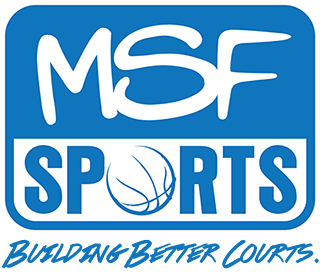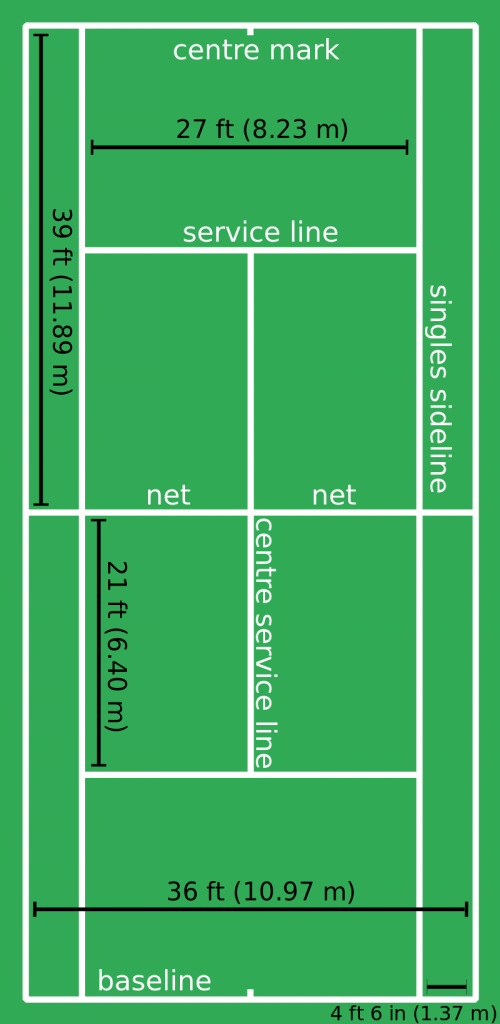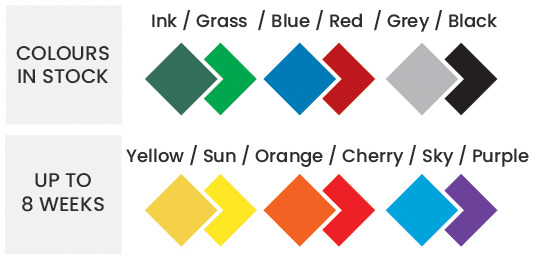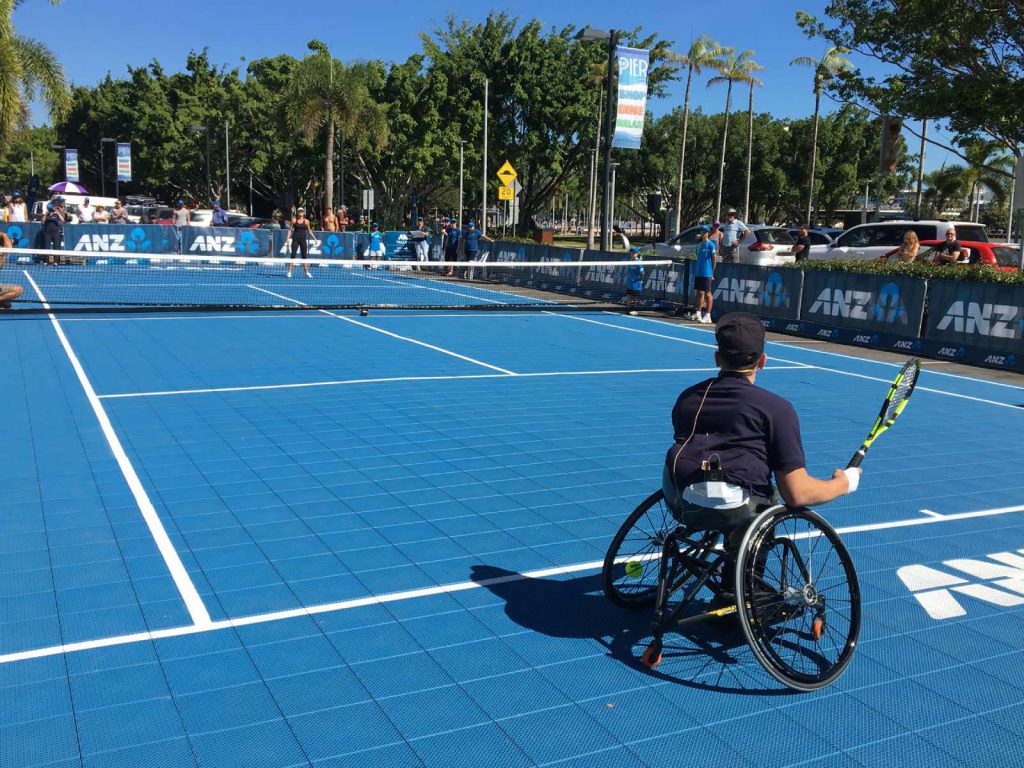Tennis Court Dimensions
A tennis court is 78 feet (23.77 metres) long. Its width is 27 feet (8.23 metres) for singles matches and 36 feet (10.97 metres) for doubles matches. The service line is 21 feet (6.40 metres) from the net.
| Dimension | International (recommended) | International (min) | Recreational (min) |
|---|---|---|---|
| Total length including run-backs | 132 ft / 40.2 m | 120 ft / 36.6 m | 114 ft / 34.8 m |
| Total width including side-run (doubles) | 66 ft / 20.1 m | 60 ft / 18.3 m | 56ft / 17.1 m |
| Run-back (distance behind the baseline) | 27 ft / 8.2 m | 21 ft / 6.4 m | 18 ft / 5.5 m |
| Side-run (distance to the side of the court) | 18 ft / 4.6 m | 12 ft / 3.7 m | 10 ft / 3.1 m |
| The spacing between multiple courts | n/a | n/a | 12 ft / 3.7 m |
In Australia, backyard Tennis courts come in a range of sizes and can be customized to suit your space and/or budget requirements. Call 1800 COURTS for a free custom tennis court design and quote.
How thick are line markings on a tennis court?
Tennis Court lines should follow standard thickness measurements, and these must be taken into account when painting Tennis Court line markings. The centre service and centre mark lines should be 5 cm wide (2 inches) wide. The other lines of a Tennis court must be between 2.5cm (1inch) to 5cm (2inches) wide, with the exception of the baseline that may be up to 10cm (4inches) wide.
What size is a tennis court in square metres?
The overall surface area of a tennis court measures 195.7 sqm for singles and 260.9 sqm for doubles.
How much total space is required to build a tennis court?
The minimum amount of space depends if the court is used for competitive play or recreational use. For recreational use, the recommended minimum length is generally around 34.8 m (114 ft) and the minimum width is 17.1 m (56 ft). A tennis court's total area size is approx 595.1 sqm.
What are the dimensions of the Australian Open tennis court?
The Australian Open tennis courts adhere to the standard dimensions set for professional play. This means the court length is 78 feet (23.77 meters), with a width of 27 feet (8.23 meters) for singles and 36 feet (10.97 meters) for doubles matches. The Australian Open primarily uses hard courts, which follow these universal dimensions.
What is tennis court size?
A standard tennis court measures 78 feet (23.77 meters) in length. For singles matches, the court width is 27 feet (8.23 meters), and for doubles matches, it expands to 36 feet (10.97 meters). This size is consistent across all types of courts, whether they are grass, clay, or hard surface.
How much room do you need around a tennis court?
To ensure players have enough space to play safely and accommodate the run-off area around the court, it's recommended to have an additional space of 21 feet (6.4 meters) at the ends of the court and 12 feet (3.66 meters) on the sides. Therefore, the total recommended space for a tennis court, including the run-off area, would be 120 feet (36.57 meters) in length and 60 feet (18.29 meters) in width. This extra space helps in preventing injuries and allows for the installation of fences, benches, and other amenities.
What is the width of the lines on a tennis court?
The lines on a tennis court have different widths. The centre service line and the centre mark are 2 inches (5 cm) wide. The other lines are between 1 inch (2.5 cm) and 2 inches (5 cm) wide, but the baselines can be up to 4 inches (10 cm) wide.
What Tennis Court surface to choose?
Each of the various Tennis court materials have varying degrees of upfront costs vs performance vs ongoing maintenance requirements. It's recommended to factor these into any decision of which type of tennis court to build:Grass: Grass courts require by far the most maintenance. The grass must be kept very short, healthy and free of weeds. This means frequent watering, fertalising and mowing.
Clay: Clay courts require less maintenance than grass. However, clay has the tendency to shift quite frequently, which requires raking or brushing back into place. During times of high winds, some clay may be blown off the court entirely. Generally new clay is required to be added each year.
Acrylic: Acrylic courts are relatively low maintenance but can lack in performance. Beyond keeping them swept and clean, they require very little upkeep.
Asphalt: Asphalt courts generally require resurfacing every few years or so. They are more susceptible to cracking, and those cracks can grow quickly to become problematic, especially in the cooler climates.

Concrete: Concrete courts are fairly low maintenance as well. They require occasional resurfacing but do not crack as frequently or as badly as asphalt.
Modular Sports Flooring: Concrete, asphalt and acrylic courts are so brutal on your joints and body, A popular new Tennis court surface solution that has been specifically designed for increased performance, longevity and a reduction in joint strain/injuries and reduced sound decibles, which is great for residential environments. Australia's top selling modular sports flooring suitable for Tennis Courts is the MSF PRO sports surface. The MSF PRO surface offers the latest cutting-edge sports technology and can be installed onto almost any hard flat subsurface base such as concrete, decking or asphalt. The tiles also come in a 16 various colours and can be easily DIY installed by almost anyone handy with tools. Click here to read more about MSF PRO modular multi sports surface for your tennis court.
MSF Sports can custom design your dream tennis court to International Tennis Federation (ITF) regulations.
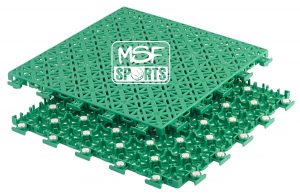
Benefits of our Tennis & Multi Sports MSF PRO Technology:
- Consistent ball bounce
- Sound reduction by 30 - 40 %
- Increased grip – anti-slip
- Saving time mowing lawns
- Add value to your property
- Save time and costs travelling to stadiums just to train
- Water drainage system – eliminates puddles, increases safety, ready to play in 10 minutes after heavy rain
- Safer and more durable – no cracking, no warping, no fading
- More economical and versatile solution for multi sports areas
- 10 year limited warranty + 20 year life expectancy
Source: https://en.wikipedia.org/wiki/Tennis_court
